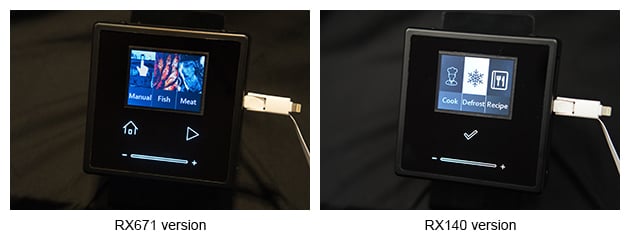Historically, home appliances primarily featured control panels made up of segment LCDs, LEDs, and physical buttons. However, a recent trend, especially in high-end models focusing on design, leans toward the adoption of TFT LCDs and capacitive touch keys. To meet to the need for TFT LCD displays in home appliances and industrial machinery, Renesas introduced the RX family MCUs equipped with a graphic LCD controller and a 2D drawing engine, providing a comprehensive solution that removes the necessity for external LCD display ICs. To further simplify the integration of TFT LCD modules across a broad spectrum of applications, we have now launched a GUI solution that utilizes SPI and is compatible with all RX family MCUs.
| GUI Solution Using Dedicated Hardware | GUI Solution Using SPI | |
|---|---|---|
| Target RX family MCU | RX65N/RX651, RX66N, RX72N, RX72M | All |
| Used hardware | Graphic LDC Controller 2D Drawing Engine | SPI |
| MCU pin used for LCD display | 22 to 30 pins | 4 pins |
Let me introduce the advantages of our GUI solution utilizing SPI.
Only 4 pins for LCD display
As the display control is done via SPI, only four pins are used: clock output, data output/input, and chip select. This means that even devices with small packages with limited pin count can control a TFT LCD module, making it easier to adapt in applications where the device mounting area is constrained.
Free-of-charge partner’s GUI library for mass production
All users of the RX family MCUs have free access to Segger's GUI library, "emWin for RX," from development right through to mass production. The emWin library is optimized for embedded applications and performs efficiently, even on RX100 series MCUs, which have limited CPU and memory resources for LCD display.
Ready-to-evaluate sample programs for QVGA LCD display available.
We've prepared these programs using an RX family MCU evaluation board (RX140, RX671), and a commercial QVGA LCD module. In addition to microwave-resembled displaying, users can experience the operation of the capacitive touch sensor at the same time.
Additionally, we have prepared a Proof of Concept (PoC) that allows you to explore the application of this solution in real-world scenarios. Like the sample programs above, its LCD display resembles a microwave’s operation on the QVGA LCD. Capacitive touch buttons and sliders are formed with transparent electrodes and are designed to stand out in white from the black casing when illuminated by LED backlight. All make the front of the casing completely flat, resulting in a modern design. The board's circuit diagram, transparent electrode, and housing design information are available online if you wish to refer to these details during your product development. If you wish to borrow this PoC, please consult our sales.

By utilizing the GUI solution of the RX family using SPI, you can upgrade to advanced HMI with limited hardware resources. Please consider it when developing next-generation products.

